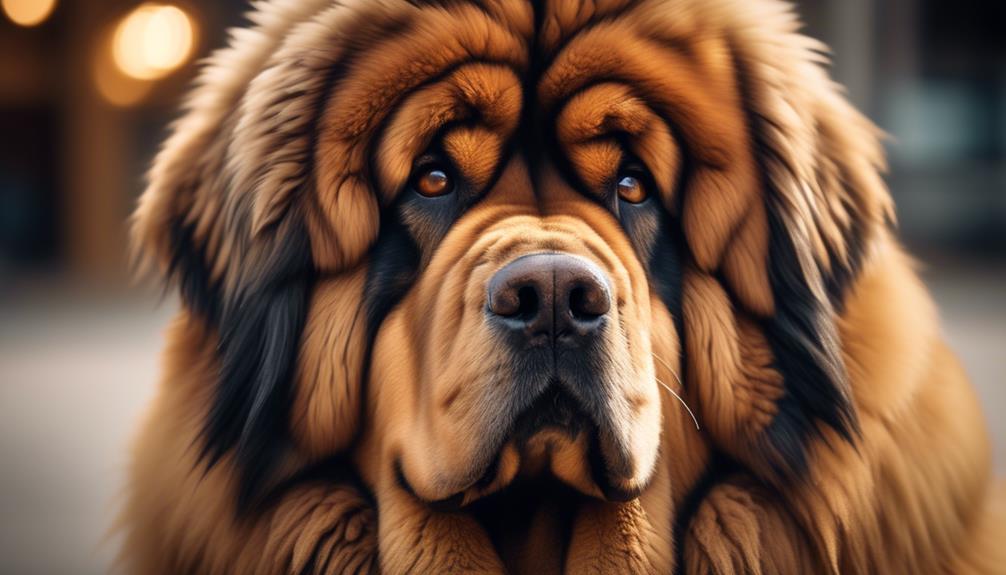
With their majestic presence and powerful demeanor, the Tibetan Mastiff commands attention wherever it goes. But there’s more to this breed than meets the eye. Known for its loyalty and intelligence, the Tibetan Mastiff possesses a unique combination of traits that make it an exceptional companion and guardian.
From its distinctive markings to its adaptability to different lifestyles, there is much to discover about the Tibetan Mastiff.
So, let’s uncover the fascinating world of this remarkable breed and explore its characteristics, care requirements, and compatibility with families and other pets.
Get ready to be captivated by the allure of the Tibetan Mastiff and all that it has to offer.
Key Takeaways
- Tibetan Mastiffs are giant working dogs with a protective and independent temperament.
- They can adapt well to apartment living, but their behavior towards neighbors and other residents should be considered.
- Exercise needs vary among different breeds, and it is important to match the dog’s energy level with your own lifestyle.
- Health and care for Tibetan Mastiffs require regular grooming, training, and proper socialization to prevent behavioral issues.
General Information
Originating from Tibet, the Tibetan Mastiff is a giant breed of working dog known for its thick double coat and protective temperament. These dogs have a lifespan of 10-14 years and belong to the working breed group.
With their intelligent and independent nature, Tibetan Mastiffs can be dominant towards other dogs. They’ve physical characteristics such as markings around the eyes and muzzle, and their undercoat can be lighter shades. While sable or brindle coats are considered faults in the show ring, they don’t affect their abilities as companions or guardians.
Grooming needs include brushing their coat 1-3 times a week, regular bathing, dental hygiene, nail trimming, and ear cleaning.
Tibetan Mastiffs are a remarkable breed with unique traits and requirements.
See another Dog breed profile.
Tibetan Spaniel Dog Breed
Origin and Size
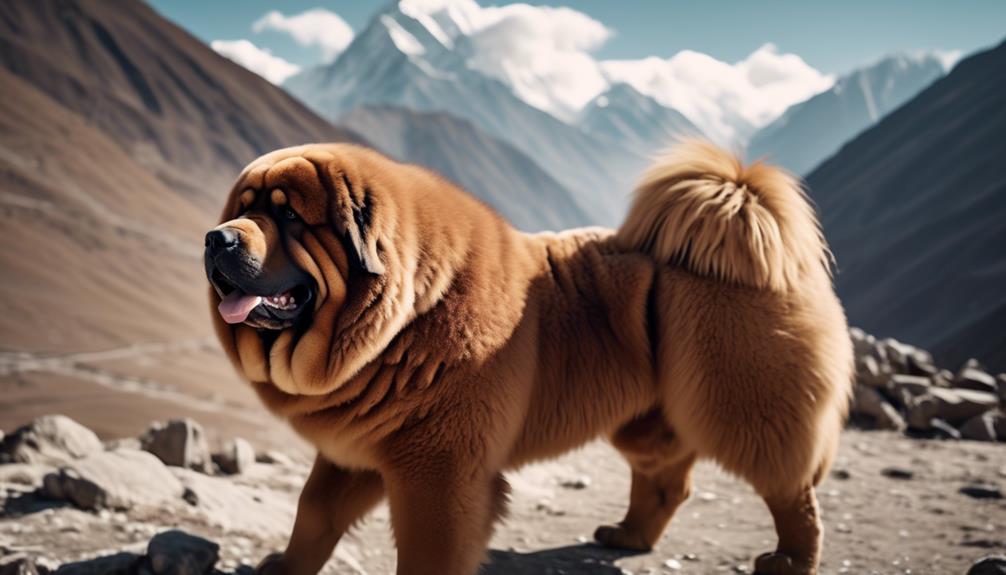
The Tibetan Mastiff, a giant breed of working dog, originated in Tibet and is known for its impressive size. The Tibetan Mastiff is one of the largest dog breeds in the world. Males typically stand between 26 and 30 inches tall at the shoulder. Females are slightly smaller, ranging from 24 to 28 inches in height. Adult Tibetan Mastiffs can weigh anywhere from 80 to 160 pounds.
These massive dogs have a strong and muscular build, with a sturdy frame and a thick double coat that provides insulation in harsh weather conditions. Their size, combined with their protective nature, makes them excellent guard dogs. However, it’s important to note that their size also requires proper training and socialization to ensure they’re well-behaved and manageable.
Breed Group and Lifespan
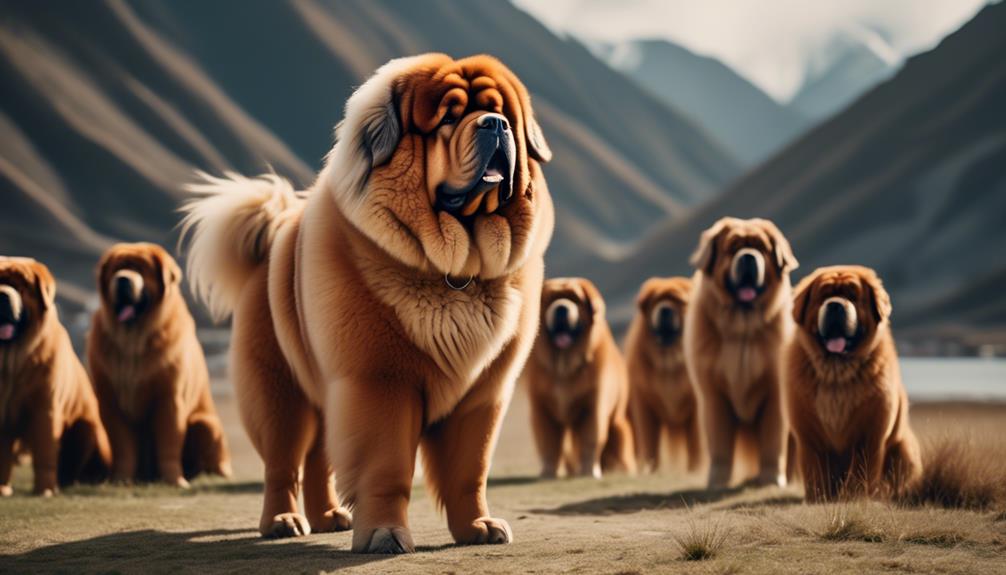
The Tibetan Mastiff belongs to the working breed group and has an average lifespan of 10 to 14 years. This breed is known for its strength, intelligence, and protective nature. They were originally bred in Tibet for guarding livestock and property. Tibetan Mastiffs are large dogs with a thick double coat that comes in a variety of colors. They have a strong and muscular build, which allows them to perform their working duties effectively. These dogs require regular exercise and mental stimulation to stay healthy and happy. Due to their protective instincts, proper training and socialization are necessary. With proper care and attention, the Tibetan Mastiff can be a loyal and loving companion for many years.
| Breed Group | Lifespan |
|---|---|
| Working | 10 to 14 years |
Coat and Temperament
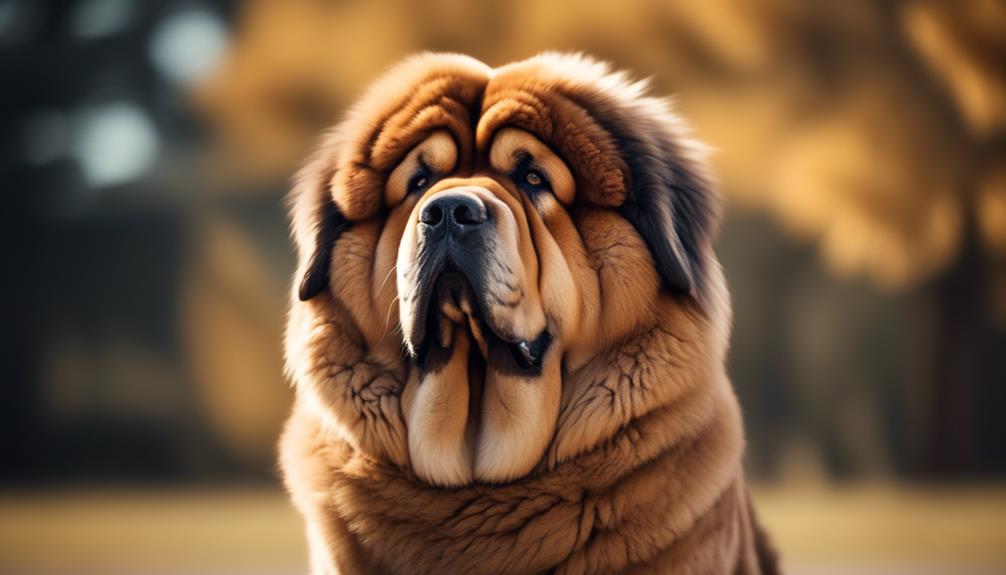
What colors can the thick double coat of the Tibetan Mastiff come in, and what’re some of the key temperament traits of this breed?
The Tibetan Mastiff’s coat can come in a variety of colors, including black, brown, gold, and gray. The most common color is black with gold markings.
As for temperament, here are some key traits of this breed:
- Protective: Tibetan Mastiffs are known for their strong protective instincts, making them excellent guard dogs.
- Dominant towards other dogs: They can be assertive and dominant towards other dogs, especially of the same sex.
- Intelligent: These dogs are highly intelligent and quick learners, which can make training easier.
- Independent: Tibetan Mastiffs have an independent nature and can be somewhat aloof with strangers.
Physical Characteristics
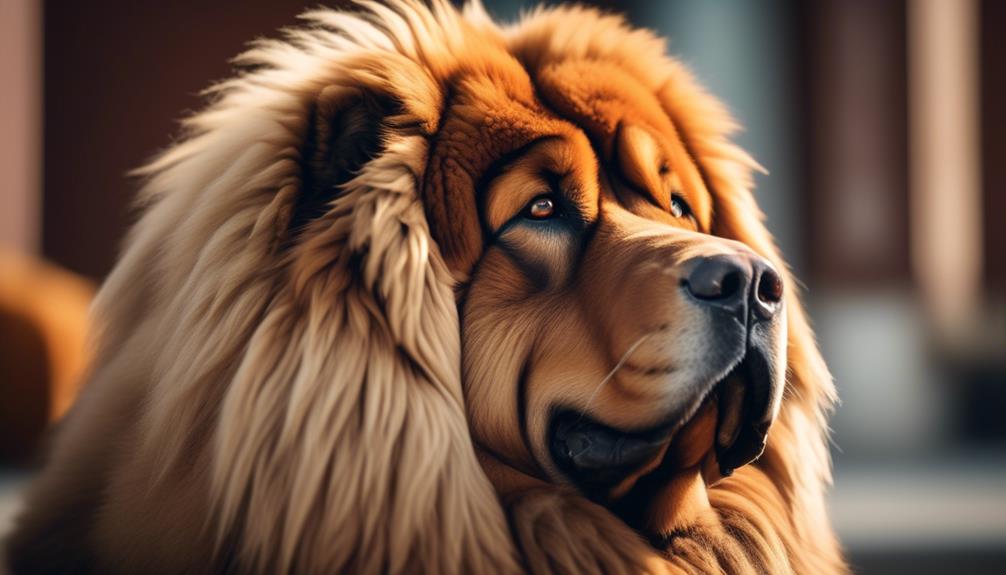
After discussing the coat colors and temperament of the Tibetan Mastiff, let’s now explore its distinct physical characteristics. The Tibetan Mastiff is a giant breed known for its impressive size and powerful build. Here are some key physical characteristics of this breed:
| Physical Characteristic | Description |
|---|---|
| Size | Giant |
| Height | 24-26 inches (males) and 22-24 inches (females) |
| Weight | 90-150 pounds (males) and 70-120 pounds (females) |
| Body Structure | Well-muscled and sturdy |
| Head | Broad and strong, with a distinctive bear-like appearance |
The Tibetan Mastiff’s physical characteristics contribute to its imposing presence and ability to excel as a guardian and protector. Its size, combined with its powerful build and strong head, make it a formidable presence. These physical traits, along with its protective nature, make the Tibetan Mastiff a highly sought-after breed for those looking for both a loyal companion and a reliable guardian.
Grooming Needs
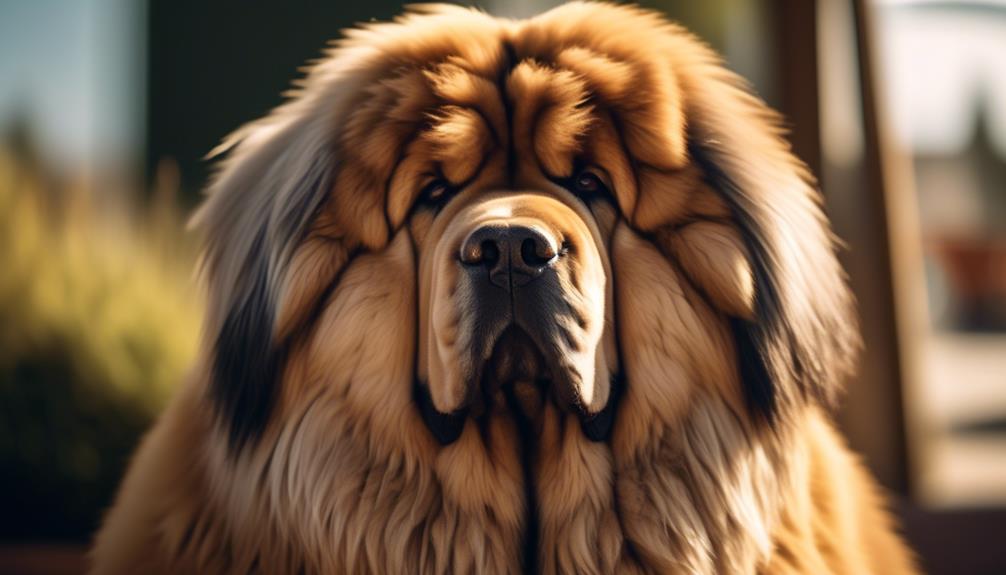
Regular grooming is essential to maintain the Tibetan Mastiff’s thick double coat and overall cleanliness. Here are some important grooming needs for this breed:
- Brushing 1-3 times a week: The Tibetan Mastiff’s coat requires regular brushing to remove loose hair and prevent matting.
- Bathing as needed: While they don’t need frequent baths, occasional bathing is necessary to keep their coat clean and healthy.
- Dental hygiene: Regular teeth brushing and dental care are important to prevent dental issues.
- Nail trimming and ear cleaning: Keeping their nails trimmed and ears clean is essential for their overall hygiene.
Adaptability for Apartment Living

Moving on to the topic of adaptability for apartment living, Tibetan Mastiffs can thrive in smaller living spaces despite their giant size. While their large stature may initially seem incompatible with apartment living, Tibetan Mastiffs are known for their calm and low-energy temperament, making them suitable for apartment dwellers. It is important to prioritize qualities such as being quiet, low-energy, and calm indoors when choosing a dog for apartment living. To give the audience a visual representation of the Tibetan Mastiff’s adaptability, a table is provided below:
| Adaptability for Apartment Living | |
|---|---|
| Size | Giant |
| Energy Level | Low |
| Noise Level | Quiet |
Choosing a Dog for Apartments
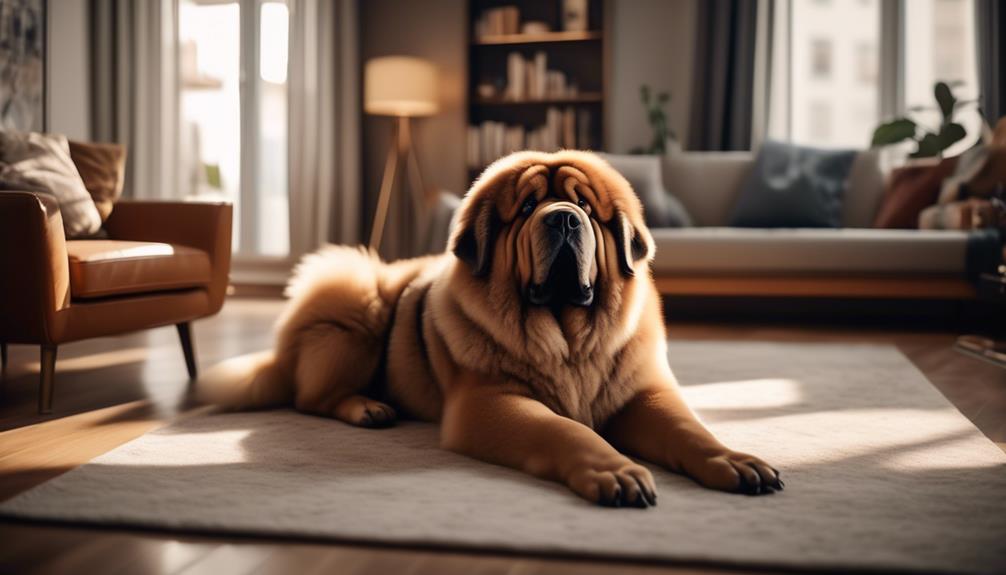
When selecting a dog for apartment living, it’s important to consider their size, behavior, and compatibility with neighbors and residents.
Size alone shouldn’t be the sole determinant for suitability. Tibetan Mastiffs can adapt well to apartment living, but other small dog breeds with higher energy levels can also thrive.
Prioritize qualities such as being quiet, low-energy, calm indoors, and exhibiting good manners.
Factors to consider when choosing a dog for an apartment include energy levels, space requirements, and the comfort of neighbors and residents.
Creating a harmonious living environment is crucial.
Exercise Needs and Playfulness
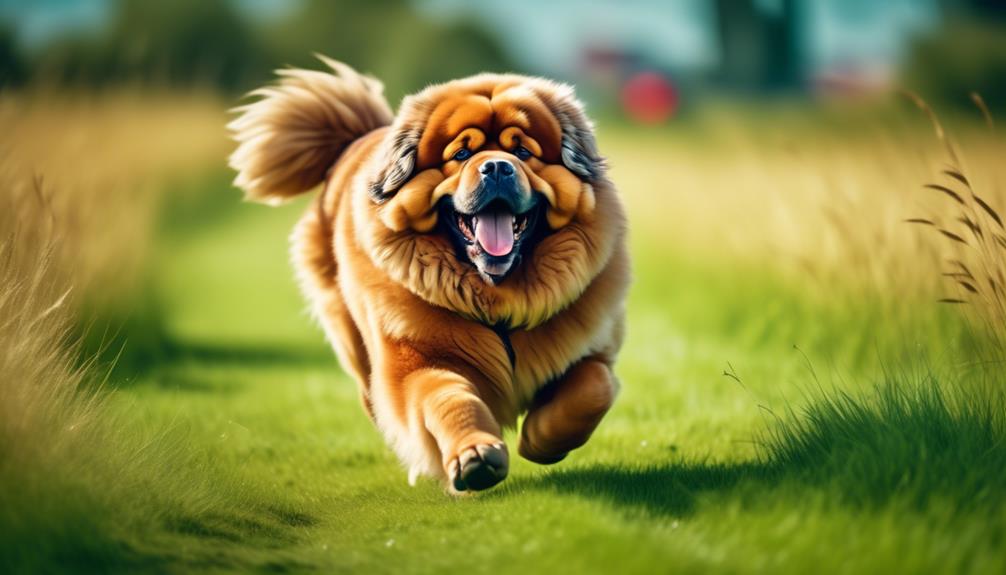
Considering the exercise needs and playfulness of a dog is crucial when choosing a breed for apartment living. Tibetan Mastiffs are generally low-energy dogs and don’t require excessive exercise. They’re content with a slow evening stroll or moderate activity level.
However, it’s important to note that they still need daily exercise to prevent weight gain and unwanted behaviors. While they may not be as playful as some other breeds, they can still enjoy the occasional game of fetch or tag.
It’s important to assess your own activity level and lifestyle before deciding on a breed. Vigorous dogs may not be suitable for homes with young children or elderly individuals, as training is necessary for them to learn good manners.
Considering Your Lifestyle
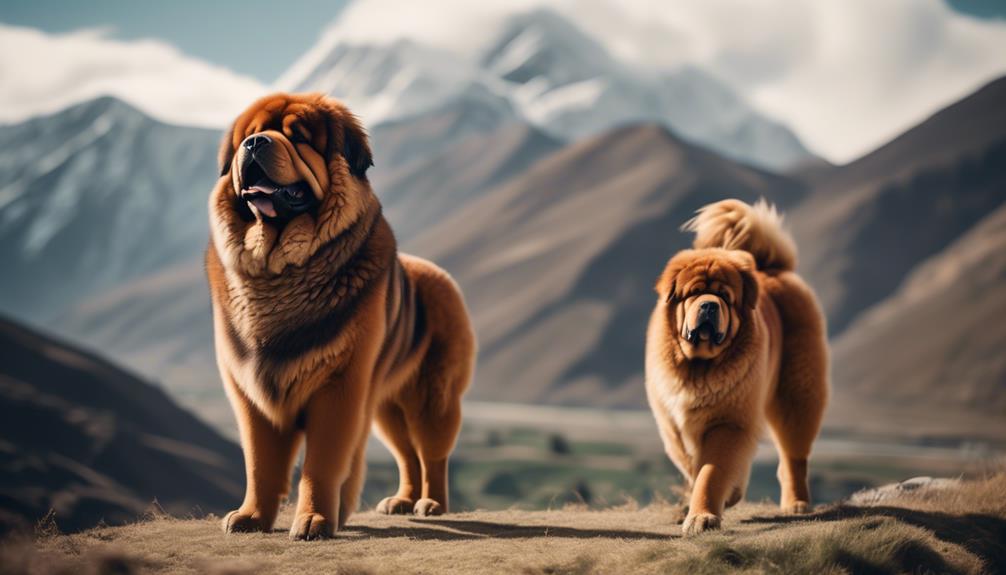
Your lifestyle plays a crucial role in determining the type of dog that will be the best fit for you. When considering a Tibetan Mastiff, it’s important to evaluate how well this breed aligns with your daily routine and preferences.
Here are a few factors to consider:
- Activity Level: Tibetan Mastiffs are generally low-energy dogs that are content with moderate exercise. If you have a busy schedule or prefer a more relaxed lifestyle, this breed may be a good fit for you.
- Space Requirements: While Tibetan Mastiffs can adapt well to apartment living, they still need sufficient space to move around comfortably. Ensure that your living environment provides enough room for this large breed.
- Time Commitment: Tibetan Mastiffs require regular grooming, exercise, and socialization. Make sure you have enough time to dedicate to their care and training.
- Noise Tolerance: Tibetan Mastiffs are known for their deep and imposing bark. If you have noise-sensitive neighbors or live in close proximity to others, consider whether this breed’s vocal tendencies align with your living situation.
Health Conditions and Care

As we move into discussing the subtopic of ‘Health Conditions and Care’, it’s important to understand the potential health issues that Tibetan Mastiffs may face throughout their lives.
Some common health conditions in this breed include Canine Hip Dysplasia (CHD), Elbow Dysplasia, Panosteitis, Osteochondritis Dissecans (OCD), Canine Inherited Demyelinative Neuropathy (CIDN), and Hypothyroidism.
To ensure the health of a Tibetan Mastiff, it’s recommended to obtain health clearances for hips, elbows, and thyroid from a reputable breeder. These dogs should live indoors with access to a large, securely fenced yard. Training, housetraining, and crate training are important for preventing destructive behavior. Leash training and socialization are necessary to prevent dominance and protectiveness.
In terms of care, Tibetan Mastiffs should be fed 4 to 6 cups of high-quality dog food per day, with meals divided into two servings. Regular brushing of the coat, bathing as needed, dental hygiene, nail trimming, and ear cleaning are also necessary.
Recommended Food and Grooming
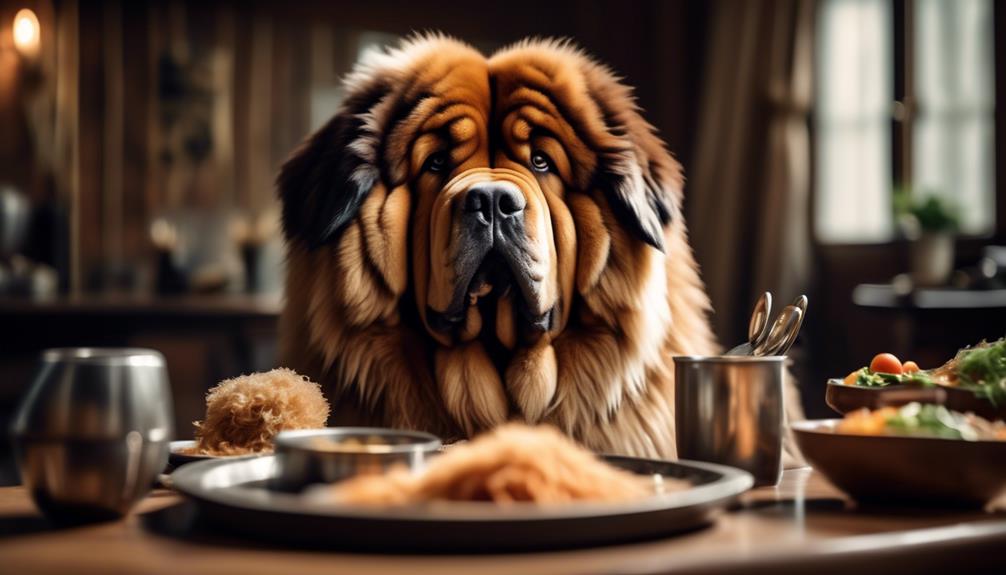
Feeding and maintaining the coat of a Tibetan Mastiff are essential aspects of their care. When it comes to their diet, it’s important to provide them with high-quality dog food and ensure they receive the recommended daily amount, which is 4 to 6 or more cups. Measuring their food and feeding them twice a day is also recommended.
As for grooming, here are some key points to keep in mind:
- Brush their thick double coat 1-3 times a week to prevent matting and remove loose hair.
- Bathe them as needed to keep their coat clean and healthy.
- Pay attention to their dental hygiene by regularly brushing their teeth.
- Trim their nails and clean their ears to avoid any discomfort or infections.
Tibetan Mastiffs With Family/Pets and Finding One
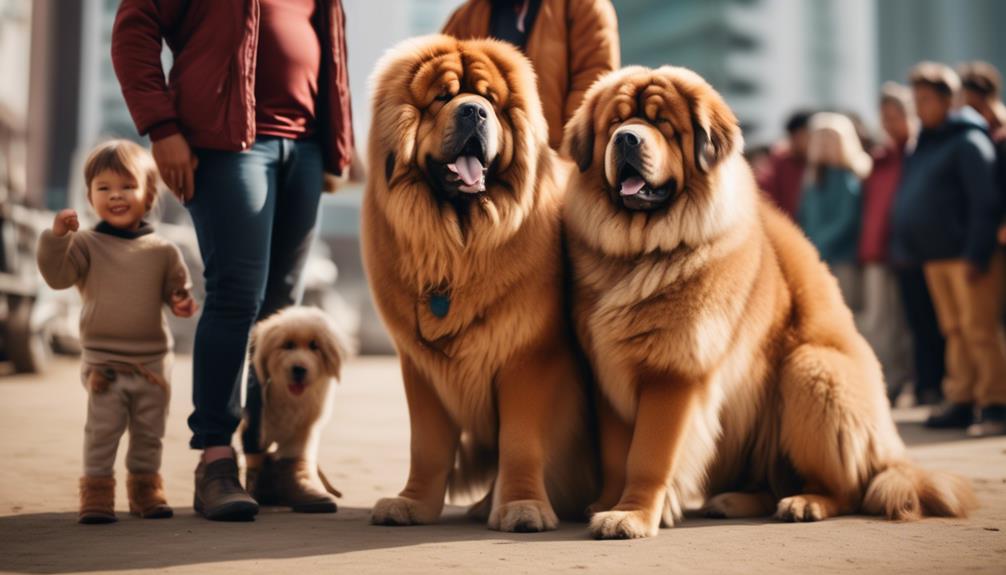
When considering Tibetan Mastiffs with family and other pets, it is important to prioritize proper introduction and socialization. Tibetan Mastiffs are generally affectionate with their family members, but their large size may make them less safe around toddlers. It is crucial to teach children to not run or scream in the presence of a Tibetan Mastiff. When raised together, Tibetan Mastiffs can be properly introduced to other dogs and cats, but it is still important to supervise their interactions. If you are looking to add a Tibetan Mastiff to your family, it is recommended to consider adopting from a rescue group before going to a breeder. Reputable breeders screen their breeding stock for health problems and socialize their puppies from a young age, ensuring a well-adjusted and healthy companion. However, it is important to be cautious of backyard breeders who may not prioritize health screening or proper socialization, which can lead to potential issues.
| Considerations | Recommendations |
|---|---|
| Proper introduction and socialization | Prioritize introduction and socialization to ensure a harmonious environment |
| Safety around toddlers | Teach children to not run or scream in the presence of a Tibetan Mastiff |
| Introducing to other pets | Properly introduce Tibetan Mastiffs to other dogs and cats when raised together |
| Adoption | Consider adopting from a rescue group before going to a breeder |
| Reputable breeders | Look for breeders who screen for health problems and socialize puppies from a young age |
Frequently Asked Questions
Are Tibetan Mastiffs Good With Children?
Tibetan Mastiffs can be good with children, but caution should be exercised due to their large size. Teaching children to not run or scream around them is important to ensure safety.
How Do Tibetan Mastiffs Behave Around Other Dogs and Cats?
Tibetan Mastiffs can exhibit dominant behavior towards other dogs and cats. Proper introduction and socialization when raised together is important. It is advised to teach children how to behave around the breed due to their large size.
What Is the Average Cost of a Tibetan Mastiff?
The average cost of a Tibetan Mastiff can vary depending on factors such as pedigree, location, and breeder reputation. It is recommended to do thorough research and expect to pay a significant amount, as Tibetan Mastiffs are generally considered a rare and expensive breed.
Are Tibetan Mastiffs Known to Be Good Guard Dogs?
Yes, Tibetan Mastiffs are known to be good guard dogs. They are protective and dominant towards other dogs, making them excellent at guarding their homes and families.
Do Tibetan Mastiffs Have Any Specific Training Needs?
Tibetan Mastiffs have specific training needs. They require proper training for housetraining, crate training, leash training, and socialization. This is important to prevent destructive behavior, dominance, and protectiveness.
Conclusion
In conclusion, the Tibetan Mastiff is a remarkable breed with a majestic presence and protective nature.
Their adaptability to apartment living may vary, but their exercise needs and playfulness make them great companions for active individuals.
With regular grooming and care, they can thrive in any environment.
While they’ve a few health conditions to be aware of, they’re generally a healthy breed.
Overall, the Tibetan Mastiff is a loyal and intelligent companion that can bring joy to any family or individual.




